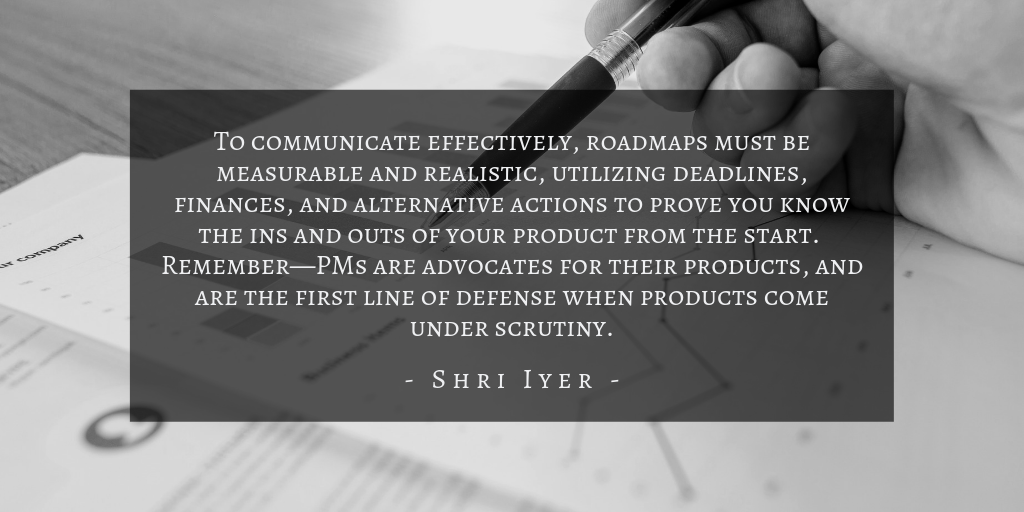Our topics thus far have mainly focused on what it means to be a successful Product Manager and the tasks that come along with the title. One of the major PM tasks that we’ve discussed is product roadmapping. For this article, we’re going to take a deeper dive into product roadmapping, highlighting exactly what it is and why it’s an essential component of successful product management.
Defining Product Roadmaps
According to ProductPlan, “A product roadmap communicates the why and what behind what you’re building. It’s a guiding strategic document as well as a plan for executing the strategy.” ProductPlan lists the ultimate goals of product roadmaps in their article, all of which I’ll cover in more depth.
So, why are product roadmaps important?
They Establish Vision and Strategy
Not every PM enjoys producing product roadmaps. They may feel that roadmaps are all bark and no bite, there to appease customers and senior leadership without having any bearing on business strategy or objectives. However, a properly-produced roadmap can be an incredible tool for all parties, PMs included. The best bare-bones brainstorm for roadmapping requires answering the questions that journalists and detectives are all-too-familiar with: who, what, when, where, why, and how. Writer and startup advisor Geoffrey Moore described a sure-fire method of visual roadmapping in his 2006 book Crossing the Chasm. In the book, he created a sentence template based on the W and H questions:
“For (target customer) who (statement of need or opportunity), the (product name) is a (product category) that (key benefit, reason to buy). Unlike (primary competitive alternative), our product (statement of primary differentiation).”
While the statement format differs from person to person, the main goal is always the same—understand your product. Roadmaps utilize this overall vision to establish common themes in the development and marketing of a product, themes that may align with the goals of the broader organization.
They Communicate Internal and External Goals

Often, a product roadmap is a story. There is a beginning, middle, and end. There is, usually, conflict of some type. In that sense, your roadmap needs to communicate this story with teammates, stakeholders, customers, and anyone else who will have access to the document.
Draft a roadmap in a way that specifies actions to take and factors to consider, but do so with accessible language and clarity. The story you tell should be a coherent one—the product’s audience, resources, and goals should be the story’s protagonists. The language and logic should be simple but effective, split up under proper headings and refined over several rounds of edits.
A successful product roadmap secures a strong buy-in from stakeholders. Consider the needs and expectations of your audience. Are you writing to customers who are loyal to your competition? Or will the document fall into the hands of fellow team members? Perhaps senior leadership will be the end-all, be-all of your product. To communicate effectively, roadmaps must be measurable and realistic, utilizing deadlines, finances, and alternative actions to prove you know the ins and outs of your product from the start. Remember—PMs are advocates for their products, and are the first line of defense when products come under scrutiny.
They Create Guidelines that Prepare Businesses for the Future

A guideline is especially important when the roadmap is for a brand-new product. Roadmap guidelines, when implemented properly, should “reduce as much ambiguity on the ‘now’, while setting some context on the future,” according to Samsung Product Manager Anu Ramakrishnan. Think of the roadmap as a path snaking into the distance; the start of the path is closest to you, and as such can be viewed with much greater detail. As the path serpentines away, the details get muddy and the width seems to shrink. Progressing along the path reveals the details of that once-distant stretch. If you see a bear further down the path, you may slow down to see if it will leave, and at some point, if it remains in place, you may veer onto a different trail. In the same vein, the roadmap can be used to focus on the present while offering a glimpse of the future, providing ample opportunity to consider alternatives and shift focus.
Additionally, roadmaps don’t have to stay the same forever. It’s completely reasonable to update your roadmap to keep up with internal and external changes. After all, significant changes to business structure and the external market can have major impacts on the reality of your vision for a product’s success.
As a whole, product roadmaps serve as written hypotheses for success. Every goal is a projection, a hope for the future backed up with primary and secondary data. The unpredictability of the market forces the hands of PMs, requiring them to consider a variety of outcomes for every element of the roadmap. As the present progresses and the distant future becomes not-so-distant, those goals should shift to more accurately represent what you’ve achieved.

